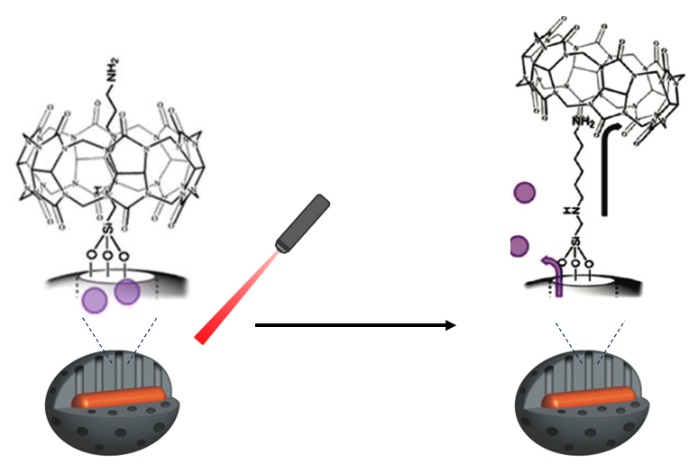Description of the internship.
Nanomachines are nanostructures that induce a movement in response to a stimulus (light, magnetic field, pH change etc.). In this study, we want to use light to destroy a molecular cap located at the entrance of pores in gold-silica nanoparticles.1 This would allow the release of drugs previously encapsulated within mesoporous silica (m-SiO2) upon irradiation. The drugs envisaged here are able to disaggregate β-amyloid plates involved in the Alzheimer disease, thus the nanomachines should be properly functionalized to allow them to reach the brain.
Gold nanorods (GNR) are very interesting for the formation of light-triggered nanomachines thanks to their ability to strongly increase their temperature after absorbing light in their plasmonic band in the near infra-red region (NIR).2,3 GNRs covered with m-SiO2 and functionalized with thermo-sensitive molecular caps should enable the opening of pores.
In this project, we propose to synthesize GNR@m-SiO2 nanoparticles absorbing in the NIR, to functionalize them with a thermosensitive supramolecular nanovalve which should ideally open around 50-60 °C, and to load drugs. Irradiation in the NIR should locally heat the surface of the nanoparticles, which would lead to the disassembly of a supramolecular nanovalve, thus liberating the entrance of the pores and allowing drug molecules to escape, such as the peptide LPFFD that disaggregate β-amyloid for a potential treatment of Alzheimer´s disease.4
The internship will cover all steps from synthesis, functionalization and characterization of the nanoparticles, to the evaluation of the actuation of the nanomachines both in solution and in vitro. The chemistry tasks will mainly be performed in Grenoble, while the biological evaluation would be performed in Chile during the M2 internship.
Internantional mobility
This project is a collaboration between the Institut Neel of Grenoble and the Univeristy of Chile at Santiago. National students of the program Soft Nano can benefit of an outgoing mobility sholarship of the Graduate School of UGA for funding part of a master-2 internship in Santiago.
Bibliography
(1) Croissant, J.; Zink, J. I. Nanovalve-Controlled Cargo Release Activated by Plasmonic Heating. J. Am. Chem. Soc. 2012, 134 (18), 7628–7631. https://doi.org/10.1021/ja301880x.
(2) Bolaños, K.; Sánchez-Navarro, M.; Giralt, E.; Acosta, G.; Albericio, F.; Kogan, M. J.; Araya, E. NIR and Glutathione Trigger the Surface Release of Methotrexate Linked by Diels-Alder Adducts to Anisotropic Gold Nanoparticles. Mater. Sci. Eng. C 2021, 131, 112512. https://doi.org/https://doi.org/10.1016/j.msec.2021.112512.
(3) Zare, I.; Yaraki, M. T.; Speranza, G.; Najafabadi, A. H.; Shourangiz-Haghighi, A.; Nik, A. B.; Manshian, B. B.; Saraiva, C.; Soenen, S. J.; Kogan, M. J.; Lee, J. W.; Apollo, N. V; Bernardino, L.; Araya, E.; Mayer, D.; Mao, G.; Hamblin, M. R. Gold Nanostructures: Synthesis, Properties, and Neurological Applications. Chem. Soc. Rev. 2022, 51 (7), 2601–2680. https://doi.org/10.1039/D1CS01111A.
(4) Soto, C.; Sigurdsson, E. M.; Morelli, L.; Asok Kumar, R.; Castaño, E. M.; Frangione, B. β-Sheet Breaker Peptides Inhibit Fibrillogenesis in a Rat Brain Model of Amyloidosis: Implications for Alzheimer’s Therapy. Nat. Med. 1998, 4 (7), 822–826. https://doi.org/10.1038/nm0798-822.

